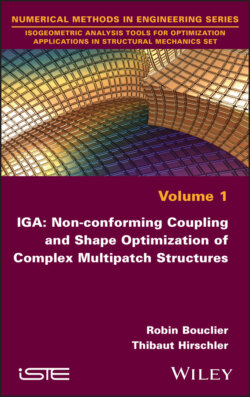Читать книгу IGA - Robin Bouclier - Страница 11
1
Introduction to IGA: Key Ingredients for the Analysis and Optimization of Complex Structures 1.1. Brief introduction
ОглавлениеIsoGeometric analysis (IGA) was originally introduced by Hughes et al. (2005) and formalized in Cottrell et al. (2009), in order to reunify the fields of geometric modeling in computer-aided design (CAD) and numerical simulation using the finite element method (FEM). The main idea is to resort to the same bases for analysis as the ones used to describe the geometry in CAD. In this framework, the method can be viewed as a generalization of the FEM that considers smooth and higher-order functions, for example, the non-uniform-rational-B-spline (NURBS) functions (Cohen et al. 1980; Piegl and Tiller 1997; Rogers 2000; Farin 2002), to replace typical Lagrange polynomials in the computations. Some other geometric descriptions include T-splines (Bazilevs et al. 2010) and subdivision surfaces (Cirak et al. 2002). Within this work, we only use the NURBS (which constitute the most commonly used technology in CAD) and simpler B-splines. We use the spline and isogeometric terminologies indifferently to denote a NURBS and a B-spline object, respectively.
Now, about 15 years after its birth, there are substantial works in the area of IGA, which makes it a very competitive methodology for the general field of scientific computing. In this chapter, we attempt to introduce IGA by providing a contemporary vision on its interests, limitations and related challenges that still need to be faced in order to meet its full potential. The discussion is performed in accordance with the core objective of this book, which is the analysis and shape optimization of complex structures. More precisely, we insist on the opportunities offered by the underlying spline technologies to represent, modify and mechanically simulate any geometrical shape in structural mechanics. We also outline the remaining issues, and the main research paths currently followed to answer them, to achieve a true dialog between CAD and FE analysis. An effort is made to help readers unfamiliar with IGA to understand all of the necessary key points related to this method. This first chapter serves as a prerequisite for the contributions presented in the next chapters of this book.
